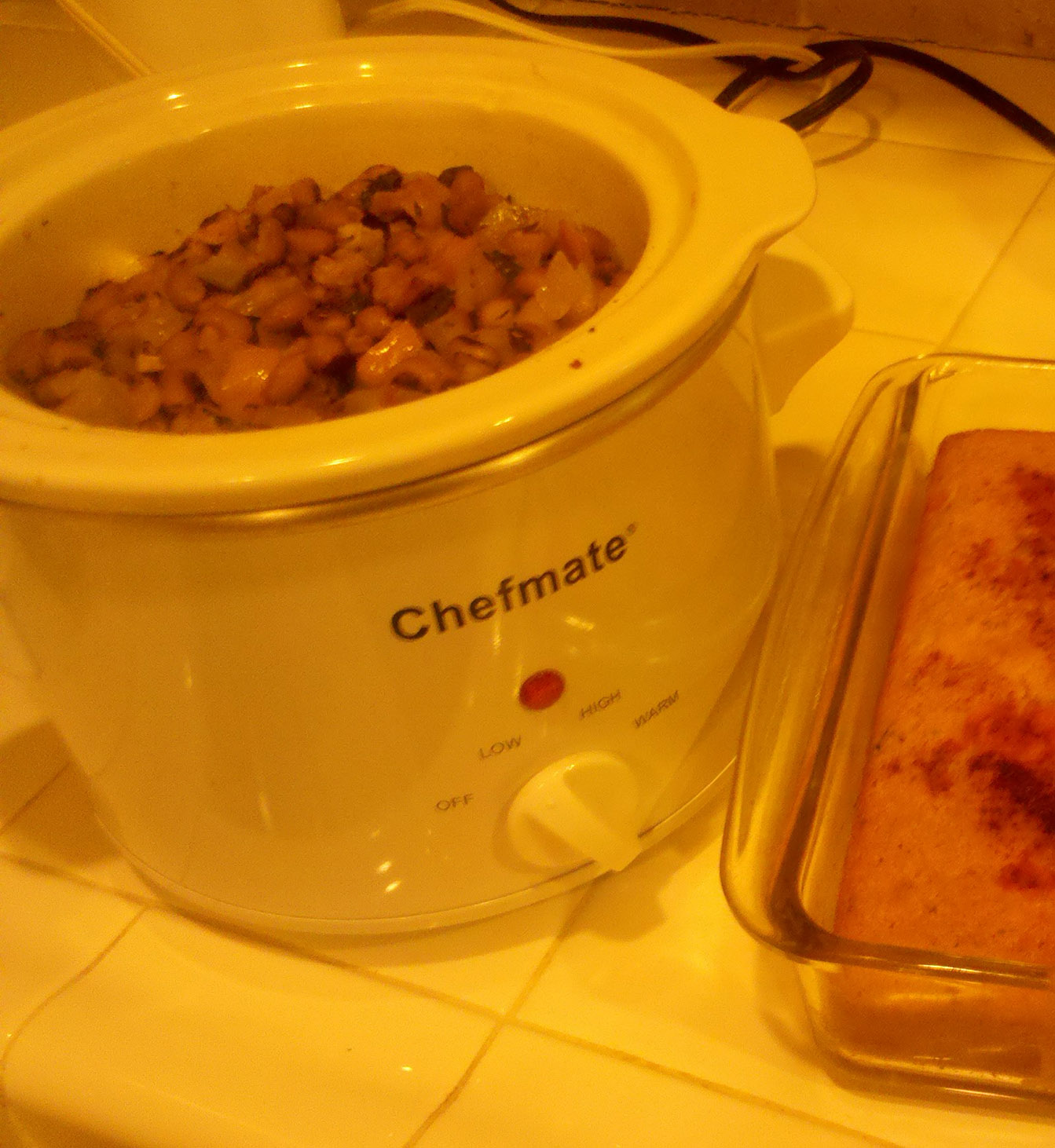
Warming my 2011 New Year's Day black-eyed peas in a crock pot, with paprika dusted cornbread on the side
Mojo’s dad, John Paul (JP) Jones, served black-eyed peas on New Year’s Day several years ago when we were visiting him in Florida. I loved them, asked him for his recipe, and make it at least once a year.
I wanted to know the history of this dish and found out it has a pedigree spanning the globe and dating back almost two thousand years! How did this ancient tradition become known in the American south? The first Sephardi Jews arrived in Georgia in the 1730s and by the American Civil War the dish was well-known in the south.
The “good luck” traditions of eating black-eyed peas at Rosh Hashana, the Jewish New Year, are recorded in the Babylonian Talmud. The peas symbolize prosperity. In the American south, the peas are often accompanied by collard or turnip greens, symbolizing money, and cornbread, symbolizing gold. There are many good luck traditions such as placing a new penny or dime in the pot. The recipient is granted extra good luck, and hopefully no broken teeth. Black-eyed peas are a good luck dish around the world.
In Portugal, black-eyed peas are served with boiled cod and potatoes, with tuna, and in salads.
In Vietnam, the peas are used in a sweet dessert of black-eyed peas and sticky rice with coconut milk).
In Greece, Turkey and Cyprus, black-eyed peas are eaten with vegetables, oil, salt, and lemon.
In the northern part of Colombia, they are used to prepare a fritter called buñuelo. The peas and egg batter is fried in hot oil, and drizzled with honey or something sweet.
In Pakistan and northern India, black-eyed peas are cooked as daal.
In West Africa and the Caribbean, a traditional dish called akkra is made of mashed black-eyed peas, salt, onions and peppers, then fried.
In Brazil’s northeastern state of Bahia, black-eyed peas are used in a traditional street food of Nigerian origin called acarajé. The beans are peeled and mashed, and the mash is made into balls and deep fried. Acarajé is typically served split in half and stuffed with diced green and red tomatoes, fried sun-dried shrimp and homemade hot sauce.
In Indonesia, black-eyed peas are commonly used in curry dishes.
Here’s JP’s recipe, the one I use, but he won’t mind if you make it your own.
1 lb. fresh or frozen black-eyed peas
2 quarts water
1 medium onion, chopped
1/2 cup each red and green bell pepper, chopped
1 Jalapeno pepper, chopped
1 tsp Thyme
1 celery stalk, chopped
1 ham bone (optional, JP doesn’t use this)
1 chunk of salt pork (JP doesn’t use this either)
salt and pepper to taste.
1. Rinse peas, soak overnight if dried. I use frozen peas usually. (I don’t like the taste of fresh peas.)
2. Drain and put dried soaked peas in a dutch oven with 2 quarts fresh water. (frozen/canned peas don’t need all the water, and I use a crockpot with my frozen beans).
3. Add remaining ingredients. I saute the veggies in a skillet first.
4. Simmer until peas soften. (2 hours dried, 30 minutes frozen/canned) Add a little water if they start getting too dry, remove lid if they are too watery.
I serve this on top of brown or white rice usually, but this year will serve it with Trader Joe’s Brown Rice Medley of long grain brown rice, black barley and daikon radish seeds. It reminds me of another southern favorite from my childhood in Louisiana and Texas, Red Beans and Rice. And I’ll serve my vegetarian black-eyed peas with cornbread again this year, made with half a can of corn, onion and peppers mixed in, and dusted with paprika for a pretty appearance. Happy New Year, everyone!
Lubiya (Sephardic Black-Eyed Peas)
3 Tbs. extra-virgin olive oil
1 medium onion, diced
2 large cloves of garlic, minced
1 1?2 cups of water
3 Tbs. tomato paste
1 lb. fresh or frozen black-eyed peas
1/2 tsp. cumin
salt and freshly ground pepper to taste
Heat a 3-quart pot over high heat for 20 seconds. Add the olive oil and heat for another 10 seconds. Add the onion and garlic and sauté over medium heat, until onions are lightly golden.
Add the water and tomato paste, and bring to a boil. Reduce the heat to low. Add the peas and cumin and cook covered for 1 to 2 hours, or until the peas are tender. It might be necessary to add a small amount of additional water to the pot if the mixture looks too dry. Conversely, if the mixture is too soupy, continue to cook uncovered, until some of the liquid has evaporated.
Remove from the heat and add salt and pepper to taste. Serve hot or at room temperature. Serve alone or over rice.
Happy New Year everyone! Do you have a tradition or recipe to share? I’d love to hear about it.
Recipes
Black-eyed Peas for Rosh Hashanah
Worldly recipes served with a slice of Jewish history
Brazilian Black-Eyed Pea and Shrimp Fritters – Acarajé
